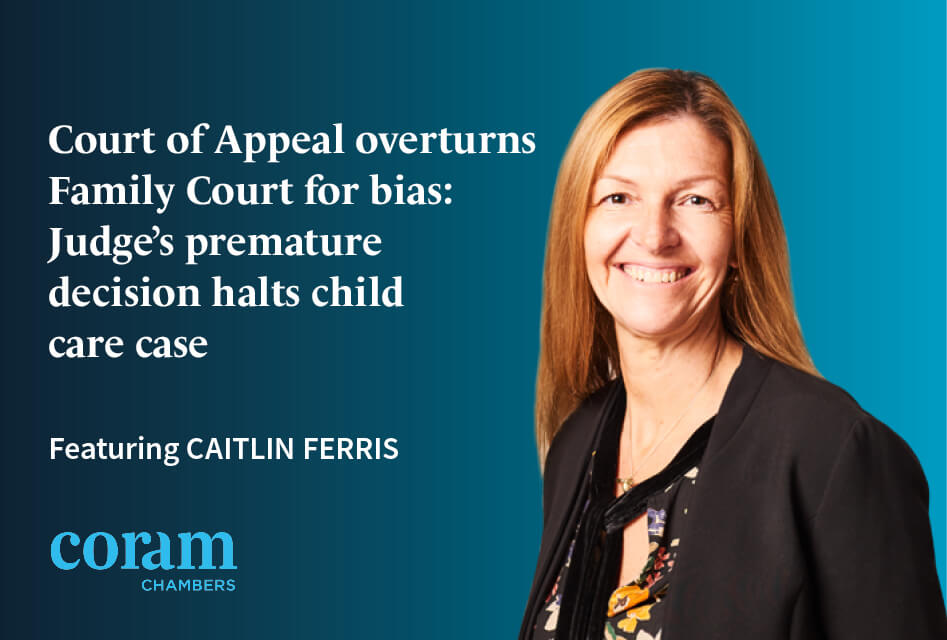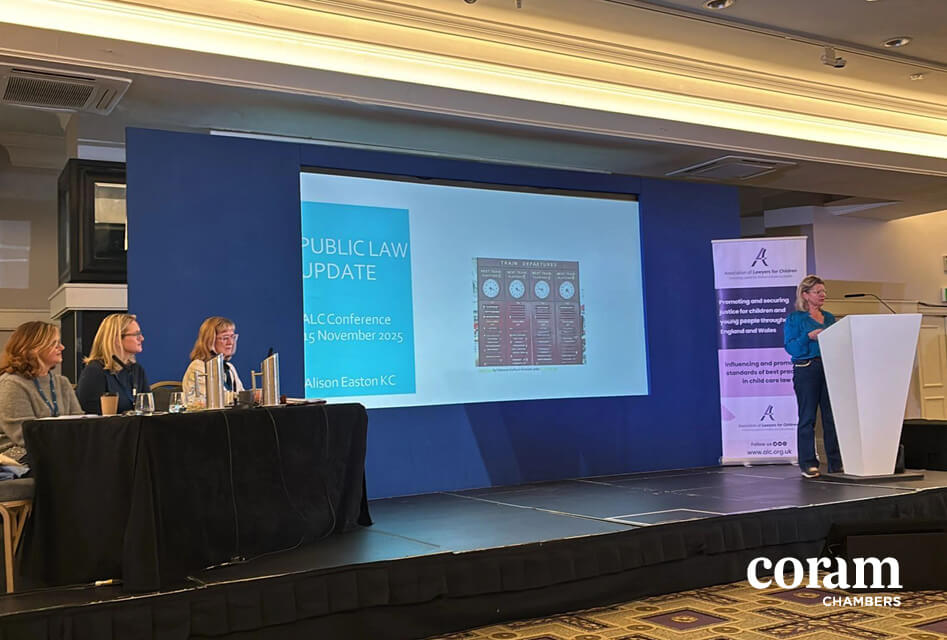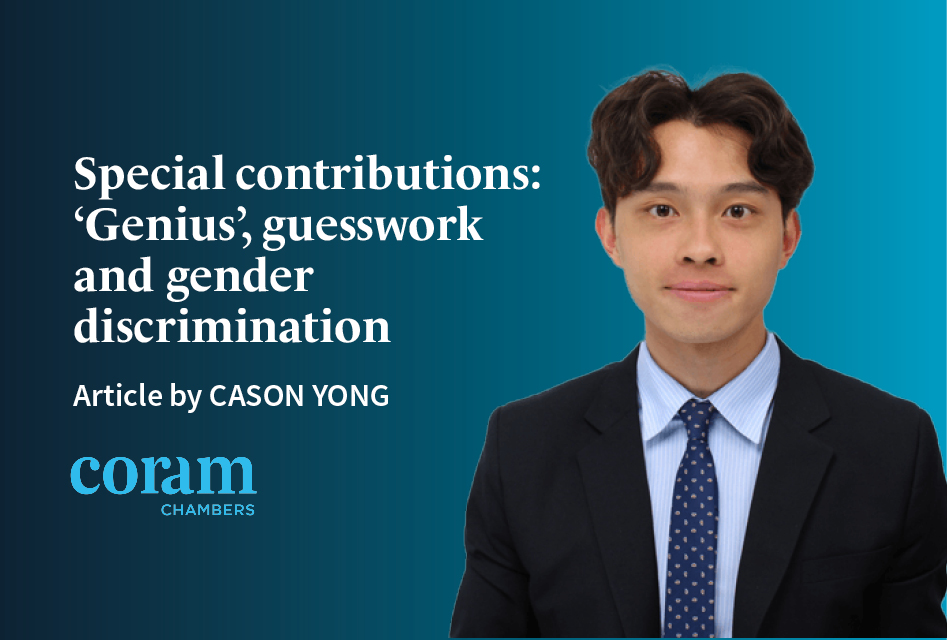Adrian Barnett-Thoung-Holland is a family barrister at Coram. His practice encompasses financial remedies and private disputes regarding children. He appeared recently in the matter of F v M [2021] EWFC 4 regarding serious allegations of coercive control and previously wrote a series of popular blogs on “Lawyers in Lockdown” at the start of the pandemic. He has written extensively on coercive control and provided a number of webinars on the topic.
In my last blog post, I covered the case of F v M [2021] EWFC 4 where I appeared for the Father. There, I considered what the future of Scott Schedules was in cases of coercive control and elucidated on some practical advice in a way forward in my webinar ‘Scott Schedules and Coercive Control: What Now?’. We have now received the Court of Appeal’s judgment in Re H-N and Others (Children) (Domestic Abuse: Finding of Fact Hearings) [2021] EWCA Civ 448 which, as mentioned before, was still outstanding when I last wrote on this subject.
I don’t intend to cover the facts of all the significant appeals in this case here – instead, I want to focus on the commentary provided by the Court of Appeal as to a) Coercive Control and b) Scott Schedules.
It’s important, as stressed in the judgment itself, that the court has limited ability to provide general guidance and observations. While the judgment is informative as to the direction we need to go from here, it doesn’t provide all the answers just yet. That will be a matter for future exploration and potentially legislation.
Coercive Control
The key paragraphs of the judgment are found at [29 – 34] addressing both coercive control and patterns of behaviour.
Firstly, the Court of Appeal fully endorses the comments of Hayden J as to examinations of coercive or controlling behaviour generally. Per para [30]:
Whilst the facts found in F v M may be towards the higher end of the spectrum of coercive or controlling behaviour, their essential character is not, and will be all too familiar to those who have been the victim of this form of domestic abuse, albeit to a lesser degree or for a shorter time. The judgment of Hayden J in F v M (which should be essential reading for the Family judiciary) is of value both because of the illustration that its facts provide of what is meant by coercive and controlling behaviour, but also because of the valuable exercise that the judge has undertaken in highlighting at paragraph 60 the statutory guidance published by the Home Office pursuant to Section 77 (1) of the Serious Crime Act 2015 which identified paradigm behaviours of controlling and coercive behaviour. That guidance is relevant to the evaluation of evidence in the Family Court.
There is self evidently no dispute that coercive control is a form of domestic abuse. The Court of Appeal also provides some examples of how coercive control in turn impacts children, which is significant to the overall question of whether a finding of fact hearing is relevant to any given case:
[Para 31] The child can be harmed in any one or a combination of ways for example where the abusive behaviour:
- Is directed against, or witnessed by, the child;
- Causes the victim of the abuse to be so frightened of provoking an outburst or reaction from the perpetrator that she/he is unable to give priority to the needs of her/his child;
- Creates an atmosphere of fear and anxiety in the home which is inimical to the welfare of the child.
- Risks inculcating, particularly in boys, a set of values which involve treating women as being inferior to men.
Of significant note is this comment, with reference to the judgment of Peter Jackson LJ in Re L (Relocation: Second Appeal) [2017] EWCA Civ 2121 at [61]. The Court of Appeal emphasises what I have previously termed ‘the knowledge component’ of coercive control:
[Para 32] It is equally important to be clear that not all directive, assertive, stubborn or selfish behaviour, will be ‘abuse’ in the context of proceedings concerning the welfare of a child; much will turn on the intention of the perpetrator of the alleged abuse and on the harmful impact of the behaviour.
One adaptation that has been added is that courts are now encouraged to go beyond even my limited assessment – that patterns of behaviour are significant to coercive control but do extend to other such forms of domestic abuse. It should no longer be the case that coercive control is a unique type of domestic abuse that relies on such patterns – the Court of Appeal makes clear that patterns of abuse play a role in all forms of domestic abuse:
[Para 33] Having considered what is controlling and coercive behaviour and emphasised the damage which it can cause to children living in a household in which it is a feature of the adult dynamics, it is necessary to move on to consider the approach of the court where the question of whether there has been a ‘pattern’ of ‘coercive’ and/or ‘controlling’ behaviour by one or more of the adults in a family is raised. Although the principal focus in this judgment has been on controlling and coercive behaviour, it should be noted that the definition of domestic abuse makes reference to patterns of behaviour not only in respect of domestic abuse refers to a ‘pattern of incidents’ not only in relation to coercive and/or controlling behaviour but to all forms of abuse including physical and sexual violence. Our observations therefore apply equally to all forms of abuse.
(My emphasis)
We have the endorsement to look at those patterns beyond just allegations of coercive control which, as seen in F v M, were seen as unique when pursuing allegations of domestic abuse. This has significant ramifications for all domestic abuse cases and how they are to be pleaded in the future.
A sterling commentary on movement away from the old approach to coercive control (and domestic abuse in general) is referred to at [50-59]. Of note, is the Court of Appeal comments that the ‘temporal’ restriction that ‘historic’ coercive control has no relevant for future contact should be pushed to one side. Here, at [52]:
The fact that there may in the future be no longer any risk of assault, because an injunction has been granted, or that the opportunity for inter-marital or inter-partnership rape may no longer arise, does not mean that a pattern of coercive or controlling behaviour of that nature, adopted by one partner towards another, where this is proved, will not manifest itself in some other, albeit more subtle, manner so as to cause further harm or otherwise suborn the independence of the victim in the future and impact upon the welfare of the children of the family.
Short answer – coercive control in the past still may have an imminent impact on what is happening in proceedings now. It’s not yet a lifting of a temporal bar per se (the court still needs to examine the association between allegations of domestic abuse to the children directly as mentioned above) but it now opens the entire history of coercive control beyond limited timespans, which had not always been the case previously.
The Court of Appeal rightly states that there needs to be proportionality at [57]. Of course, the scope of examining coercive control has been (sort of) extended now, but to what extent can this be done proportionally and property within the already overloaded timescales of family proceedings? That is something for the future it seems.
Scott Schedules
The concerns about Scott Schedules, which I have voiced on numerous occasions now, were raised in depth and are discussed at [41-49].
[44] Concern about the utility of Scott Schedules was raised on two different bases: one of principle and the other more pragmatic. The principled concern arose from an asserted need for the court to focus on the wider context of whether there has been a pattern of coercive and controlling behaviour, as opposed to a list of specific factual incidents that are tied to a particular date and time. Abusive, coercive and controlling behaviour is likely to have a cumulative impact upon its victims which would not be identified simply by separate and isolated consideration of individual incidents.
[45] The second, more pragmatic, criticism is not unrelated to the first. As an example in one of these four appeals, the parties were required to ‘limit’ the allegations to be tried to ten and the judge at trial further reduced the focus of the hearing by directing that only three would be tried. It was submitted that that very process of directed selection, produces a false portrayal of the couple’s relationship. If such an applicant succeeds in proving the three remaining allegations, there is a risk that the court will move forward on the basis that those three episodes are the only matters ‘proved’ and therefore the only facts upon which any adverse assessment of the perpetrator’s future risk falls to be made. By reducing and then further reducing its field of focus, the court is said to have robbed itself of a vantage point from which to view the quality of the alleged perpetrator’s behaviour as a whole and, importantly, removed consideration of whether there was a pattern of coercive and controlling behaviour from its assessment.
(My emphasis).
And then one of the most important parts of the entire judgment. The Court of Appeal accepts the limited advantage of Scott Schedules (shared by the Harm Panel). There has to be another way forward to address this; as the judgment puts it:
[46] For our part, we see the force of these criticisms and consider that serious thought is now needed to develop a different way of summarising and organising the matters that are to be tried at a fact-finding hearing so that the case that a respondent has to meet is clearly spelled out, but the process of organisation and summary does not so distort the focus of the court proceedings that the question of whether there has been a pattern of behaviour or a course of abusive conduct is not before the court when it should be. This is an important point. Everyone agrees.
(My emphasis)
Of course, the Court of Appeal at [48-49] can’t suggest right now what the exact answer is – much of my commentary in the past about ‘Umbrella Schedules’ probably stands in the interim but that is (depending on how you look at it) either a complete loophole, a complex workaround or just plain inconsistent with how Scott Schedules should be approached. It seems to be the practical norm for now but what of the future? But now, we finally have a formal judicial endorsement that we need to move away from Scott Schedules and their application in domestic abuse cases. What we are still to wait for is how exactly we’re going to do that.
The List of ‘Pointers’
The round out the dramatic progress achieved in this judgment, the Court of Appeal has provided some ‘pointers’ to the Ministry of Justice on how to proceed. I do like the term ‘pointers’ – it communicates neither orders, guidance or commands but rather gives a strong sense of suggestion with soft force.
Those pointers are laid out at [58-59] and go as follows:
a) PD12J (as its title demonstrates) is focussed upon ‘domestic violence and harm’ in the context of ‘child arrangements and contact orders’; it does not establish a free-standing jurisdiction to determine domestic abuse allegations which are not relevant to the determination of the child welfare issues that are before the court;
b) PD12J, paragraph 16 is plain that a fact-finding hearing on the issue of domestic abuse should be established when such a hearing is ‘necessary’ in order to:
- Provide a factual basis for any welfare report or other assessment;
- Provide a basis for an accurate assessment of risk;
- Consider any final welfare-based order(s) in relation to child arrangements; or Judgment Approved by the court for handing down.
- Consider the need for a domestic abuse-related activity.
c) Where a fact-finding hearing is ‘necessary’, only those allegations which are ‘necessary’ to support the above processes should be listed for determination;
d) In every case where domestic abuse is alleged, both parents should be asked to describe in short terms (either in a written statement or orally at a preliminary hearing) the overall experience of being in a relationship with each other.
[59] Where one or both parents assert that a pattern of coercive and/or controlling behaviour existed, and where a fact-finding hearing is necessary in the context of PD12J, paragraph 16, that assertion should be the primary issue for determination at the fact-finding hearing. Any other, more specific, factual allegations should be selected for trial because of their potential probative relevance to the alleged pattern of behaviour, and not otherwise, unless any particular factual allegation is so serious that it justifies determination irrespective of any alleged pattern of coercive and/or controlling behaviour (a likely example being an allegation of rape).
These pointers are important. (Obviously). Coercive control becoming the central theme of a fact-finding due to its complexity is an unmistakably enormous move forward in the recognition of this sort of behaviour. We now have a type of ‘value’ assessment of domestic abuse allegations with recognition that not all such allegations can be litigated equally. That was the entire problem – coercive control was being litigated in the same way as sexual, physical and verbal abuse with no recognition of its unique personality. If these pointers inform the right people properly, the courts have successfully moved it to a position where its unique identity is examined properly and fully.
The remainder of the judgment deals with other important aspects such as the relevance of criminal proceedings in findings of fact and approach to appeals against fact-findings. In terms of the appeals as a whole, three were granted, while one was dismissed. I won’t deal with the specifics of those appeals here today.
What we can take away from all of this is that the Court of Appeal has made the statement to move us in a new direction – though right now, no one can say what the new direction precisely looks like. The improved recognition of coercive and/or controlling behaviour and the questionable usefulness of Scott Schedules have taken us forward from F v M into new territory. It remains to be seen what that might look like.


